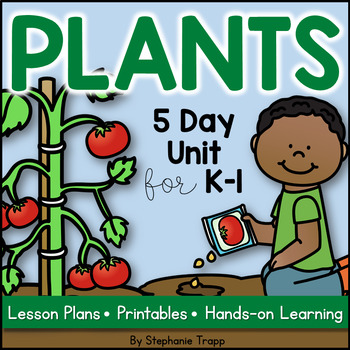Plant Unit for Kindergarten and First Grade
- PDF
What educators are saying
Description
Throw a plant tasting party, germinate beans, act out the plant life cycle and MORE during this seeds and plants unit for kindergarten and first grade! The week-long comprehensive unit includes detailed daily lesson plans with literature suggestions. It incorporates science, reading, writing, math, handwriting and art. It also includes QR codes and links to videos that complement the unit study.
Click on the PREVIEW to read each lesson plan, as well as see examples of printables and art projects.
Teacher Features You’ll Love:
- Detailed daily lesson plans
- Week-at-a-glance planning guide
- Guide for stretching the unit over two weeks
- Key concepts and objectives
- Extensive literature list
- Video links and QR codes
- Activity directions and printable templates
- Worksheets with and without handwriting lines
What’s Covered in the Unit?
Day 1: Investigating & Germinating Seeds
- Seed investigation activity
- Begin germinating beans
- What’s Inside a Bean? activity
- Begin All About Plants book
Day 2: How Seeds Travel
- Why Plants Need Space activity
- Learning with Seeds activities
- Add to All About Plants book
Day 3: Plant Life Cycle
- Act Out Plant Life Cycle
- Add to All About Plants book
Day 4: Parts of a Plant
- Parts of a Plant art or lollipop model
- Parts of a Plant song
- Color changing experiment
- Add to All About Plants book
Day 5: Parts of Plants We Eat
- Plant Tasting Party
- Parts of Plants We Eat sort
- Finish All About Plants book
Math Connections:
- Activities for a math center
- Ordering numbers least to greatest
- Counting within 10 and 100
- Counting by 10
- Tally marks
- Ten frames
- Finding one more/less and ten more/less
- Place value: tens and ones
- Addition & subtraction with a number line within 10 and 20
- Missing numbers in addition & subtraction
- Addition & subtraction within 10, 20 and 100
- Making ten
- Comparing numbers: larger/smaller and with >, < and =
- Time to the hour
- Counting dimes, nickels and pennies
- Graphing
- Measuring with nonstandard units
- Word problems
Literacy Connections:
- Plants word wall cards
- All About Plants book
- “Our Big Garden” emergent reader
- Sight word and spelling word literacy center activity
- Beginning and medial letter sounds
- Short vowel i sound
- CVC focus word: dig
- Vowel team -ee
- Beginning and ending blends & digraphs
- Rhyming
- Sight word story
- Adjectives
- Plant report writing
- The Magic Seed writing
- A Seed’s Special Trip writing
- My Garden writing
- Would You Rather…? opinion writing
Note: The Parts of a Plant Lollipop Model from day four of the unit may be purchased separately in my store. You DO NOT need to purchase it individually if you purchase the unit.
Questions? Feel free to contact me through the Q&A tab here or email me at primarythemepark@gmail.com.
Find more cross-curricular units for K-1 HERE!
Thanks so much for stopping by!





